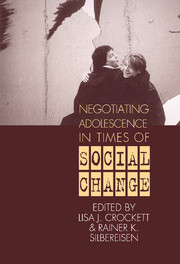Book contents
- Frontmatter
- Contents
- Contributors
- Preface
- 1 Social Change and Adolescent Development: Issues and Challenges
- Part I Models of Social Change Effects
- Part II Social Change and Adolescent Transitions
- 5 The Global Spread of Adolescent Culture
- 6 Social Change and the Sequencing of Developmental Transitions
- 7 German Unification and Adolescents' Developmental Timetables: Continuities and Discontinuities
- 8 Adolescents in Changing Social Structures: Bounded Agency in Life Course Perspective
- Part III Social Change and Adolescents' Social Contexts
- Part IV Implications of Social Change for Adolescent Health and Well-Being
- Part V Interventions: Promoting Healthy Development in Times of Social Change
- Endnotes
- Index
5 - The Global Spread of Adolescent Culture
Published online by Cambridge University Press: 26 January 2010
- Frontmatter
- Contents
- Contributors
- Preface
- 1 Social Change and Adolescent Development: Issues and Challenges
- Part I Models of Social Change Effects
- Part II Social Change and Adolescent Transitions
- 5 The Global Spread of Adolescent Culture
- 6 Social Change and the Sequencing of Developmental Transitions
- 7 German Unification and Adolescents' Developmental Timetables: Continuities and Discontinuities
- 8 Adolescents in Changing Social Structures: Bounded Agency in Life Course Perspective
- Part III Social Change and Adolescents' Social Contexts
- Part IV Implications of Social Change for Adolescent Health and Well-Being
- Part V Interventions: Promoting Healthy Development in Times of Social Change
- Endnotes
- Index
Summary
Look at your fellow passengers on any train in Europe. If there are adolescents among them, try to guess their nationality. It will be difficult, because young people all over Europe wear the same kinds of clothing and style their hair in similar ways. Teenagers in Indonesia buy the magazine Topchords to learn the guitar chords and lyrics of popular Indonesian and Western songs. Within 2 years of the loosening of restrictions in China, urban adolescents and youth were using available fabrics to copy, to the best of their ability, the dress of their Western counterparts. Quechuan teenagers, in the high Andes Mountains, listen to tapes of popular North American music. In the small cities of Morocco, young people imitate their glamorous cousins who return home for visits from France or Germany with their emigrant parents. Adolescent culture has spread throughout Europe and is moving far from its European and American homeland. What is adolescent culture? Is it a product of the industrial or postindustrial age? How does it affect the lives of its participants?
Locating Adolescent Culture
Culture is one of those terms whose very usefulness, which lies in its flexibility and applicability to a number of distinct phenomena, makes it ambiguous. Anthropologists usually employ it to cover the total way of life of a people, focusing on either the behavioral or the ideological according to their theoretical stance. I am taking one aspectexpressive culture (the aesthetic, ritual, and leisure-time pursuits of a category of people) – and overlapping it with material culture (the products of human thought, effort, and skill).
- Type
- Chapter
- Information
- Negotiating Adolescence in Times of Social Change , pp. 71 - 88Publisher: Cambridge University PressPrint publication year: 1999
- 10
- Cited by



